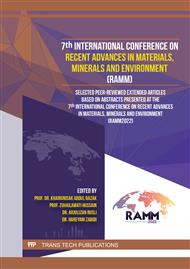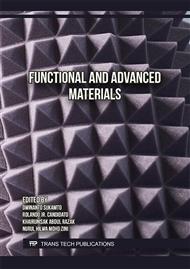[1]
J.R. Agarwal, C.F. Torres, S. Shah, Development of Dimensionless Parameters and Groups of Heat and Mass Transfer to Predict Wax Deposition in Crude Oil Pipelines, ACS Omega. 6 (2021) 10578–10591.
DOI: 10.1021/acsomega.0c05966
Google Scholar
[2]
A.M. Al-Sabagh, M.A. Betiha, D.I. Osman, A.I. Hashim, M.M. El-Sukkary, T. Mahmoud, Preparation and Evaluation of Poly(methyl methacrylate)-Graphene Oxide Nanohybrid Polymers as Pour Point Depressants and Flow Improvers for Waxy Crude Oil, Energy & Fuels. 30 (2016) 7610–7621.
DOI: 10.1021/acs.energyfuels.6b01105
Google Scholar
[3]
O.S. Alade, A. Hassan, M. Mahmoud, D. Al-Shehri, A. Al-Majed, Novel Approach for Improving the Flow of Waxy Crude Oil Using Thermochemical Fluids: Experimental and Simulation Study, ACS Omega. 5 (2020) 4313–4321.
DOI: 10.1021/acsomega.9b04268
Google Scholar
[4]
B. Hammouda, Temperature Effect on the Nanostructureof SDS Micelles in Water, J. Res. Natl. Inst. Stand. Technol. 118 (2013) 151.
DOI: 10.6028/jres.118.008
Google Scholar
[5]
N. Li, G. Mao, X. Shi, S. Tian, Y. Liu, Advances in the research of polymeric pour point depressant for waxy crude oil, J. Dispers. Sci. Technol. 39 (2018) 1165–1171.
DOI: 10.1080/01932691.2017.1385484
Google Scholar
[6]
C. Ma, Y. Lu, C. Chen, K. Feng, Z. Li, X. Wang, J. Zhang, Electrical Treatment of Waxy Crude Oil To Improve Its Cold Flowability, Ind. Eng. Chem. Res. 56 (2017) 10920–10928.
DOI: 10.1021/acs.iecr.7b02140
Google Scholar
[7]
J. Mao, Z. Kang, X. Yang, C. Lin, L. Zheng, M. Zuo, J. Mao, S. Dai, J. Xue, D. Ouyang, Synthesis and Performance Evaluation of a Nanocomposite Pour-Point Depressant and Viscosity Reducer for High-Pour-Point Heavy Oil, Energy & Fuels. 34 (2020) 7965–7973.
DOI: 10.1021/acs.energyfuels.9b04487
Google Scholar
[8]
R.A. Pratiwi, A.B.D. Nandiyanto, How to Read and Interpret UV-VIS Spectrophotometric Results in Determining the Structure of Chemical Compounds, Indones. J. Educ. Res. Technol. 2 (2022) 1–20.
DOI: 10.17509/ijert.v2i1.35171
Google Scholar
[9]
R. Sharma, B. Deka, V. Mahto, H. Vuthaluru, C.-Z. Li, Investigation into the Flow Assurance of Waxy Crude Oil by Application of Graphene-Based Novel Nanocomposite Pour Point Depressants, Energy & Fuels. 33 (2019) 12330–12345.
DOI: 10.1021/acs.energyfuels.9b03124
Google Scholar
[10]
R. Sharma, V. Mahto, H. Vuthaluru, Synthesis of PMMA/modified graphene oxide nanocomposite pour point depressant and its effect on the flow properties of Indian waxy crude oil, Fuel. 235 (2019) 1245–1259.
DOI: 10.1016/j.fuel.2018.08.125
Google Scholar
[11]
N. Sunday, A. Settar, K. Chetehouna, N. Gascoin, An Overview of Flow Assurance Heat Management Systems in Subsea Flowlines, Energies. 14 (2021) 458.
DOI: 10.3390/en14020458
Google Scholar
[12]
A. Tehrani-Bagha, K. Holmberg, Solubilization of Hydrophobic Dyes in Surfactant Solutions, Materials (Basel). 6 (2013) 580–608.
DOI: 10.3390/ma6020580
Google Scholar
[13]
M.A. Theyab, Wax deposition process: mechanisms, affecting factors and mitigation methods, Open Access J. Sci. 2 (2018).
DOI: 10.15406/oajs.2018.02.00054
Google Scholar
[14]
G. Vinay, P.T. Bhaskoro, I. Hénaut, M.Z. Sariman, A. Anuar, S.R.M. Shafian, A methodology to investigate factors governing the restart pressure of a Malaysian waxy crude oil pipeline, J. Pet. Sci. Eng. 208 (2022) 109785.
DOI: 10.1016/j.petrol.2021.109785
Google Scholar
[15]
H. Wang, L. Wang, S. Meng, H. Lin, M. Correll, Z. Tong, Nanocomposite of Graphene Oxide Encapsulated in Polymethylmethacrylate (PMMA): Pre-Modification, Synthesis, and Latex Stability, J. Compos. Sci. 4 (2020) 118.
DOI: 10.20944/preprints202007.0647.v1
Google Scholar
[16]
M.K. Yazdi, M.B. Bakar, N.A.N. Nik Malek, One pot synthesis of PMMA/silver nanoparticles and its antibacterial properties, Malaysian J. Fundam. Appl. Sci. 16 (2020) 360–365.
Google Scholar
[17]
A. Zielińska, F. Carreiró, A.M. Oliveira, A. Neves, B. Pires, D.N. Venkatesh, A. Durazzo, M. Lucarini, P. Eder, A.M. Silva, A. Santini, E.B. Souto, Polymeric Nanoparticles: Production, Characterization, Toxicology and Ecotoxicology, Molecules. 25 (2020) 3731.
DOI: 10.3390/molecules25163731
Google Scholar



